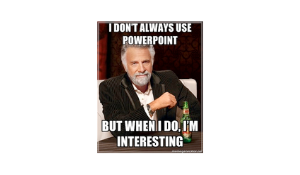Powerful Presentations Use Less Words
Get Big Rewards for Using Less One of the biggest temptations when building PowerPoint presentations is to jam all your thoughts on screen without...
2 min read
 Hunter Hays
:
Apr 7, 2017 9:02:00 AM
Hunter Hays
:
Apr 7, 2017 9:02:00 AM

There's no doubt that a well-designed presentation can increase audience engagement and lead to higher information retention. But the question is, how do you draw attention to your topic without distracting (or boring) your audience to death?
Using the right visual aids can greatly enhance the effectiveness of your presentations, while ugly slides can easily cause your audience to tune out. So what is the secret sauce? What gives a PowerPoint that magic touch that can captivate listeners and accenuate every point? Let's consider a few principles.
Read More Avoiding Death by PowerPoint
One of the most basic rules to keep in mind is that less is more. Especially when it comes to word count, finding the right balance of words on a slide can make or break a presentation. Here's a simple rule of thumb for business presentations:
This will leave more screen real estate for aesthetic backgrounds and imagination-prodding imagery. Condensing the words on screen will also help you refine your most important points. Remember, you can always vocalize more than appears on screen. However, too much reading material will take away from what you are trying to communicate.
As professional powerpoint experts, we've seen time and again that the best presentations thrive on a structured, well ordered, story line. We recommend constructing tightly drawn outlines before beginning to write. The time you put into your outline is just as important, if not more important than the time a designer puts into making it beautiful.
When organization and visual aids work together, amazing things happens. Use color cues to separate different areas of the presentation and it will keep your audience from getting lost. This is especially helpful when there are several products or services being discussed within one presentation.
When marketing with PowerPoint, the reason to add imagery to words is to make use of both sight and sound. All professional PowerPoint presentations should reinforce spedific ideas by optimizing sensory experience. Though there are many techniques that go into the design aspect of your presentation, a few ground rules can be helpful to keep in mind:
Animation tends to fare well with large audiences but with a caveat. PowerPoint itself separates animation into categories ranging from basic, to moderate, and exciting. Keeping the animation simple actually delivers a more emphatic, less distracting message.
Animation can also serve you well when you have a lot of information to convey or when illustrations are multi-layered on one slide. For instance, presentations for technical decision makers (TDM's) may have complicated steps or detailed diagrams that benefit from animated explanation. That said, never overuse it. Try to only draw attention to major points and don't allow animation to distract from the key content of your message.
Need Help with Your PowerPoint? Get a Free Three-Slide Makeover
Also consider where you will be presenting. If it's in person, animation usually works seamlessly. However, if you try to incorporate lots of movement on a streaming feed such as screen sharing or webinars, the amount of bandwidth may slow things down and make animations appear choppy.
For more information on what makes great presentations stay tuned for future blogs. We'll be posting more on this, and if you'd like, you can even download our free business PowerPoint template to get started making your own great designs.
Need even more right now? Feel free to reach out to us for full presentation support.

Get Big Rewards for Using Less One of the biggest temptations when building PowerPoint presentations is to jam all your thoughts on screen without...

We use presentations as a means of communication. Projected slides should be as visual as possible and support our point quickly, efficiently and...

Death by PowerPoint. Any of us have experienced this – all of us, and we’ve all probably been guilty of it at some point. But in a world of bullet...